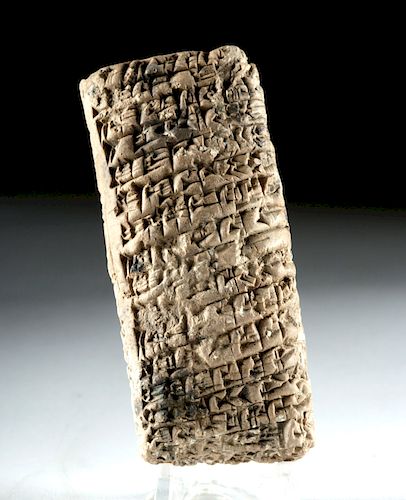Mesopotamian Clay Cuneiform Tablet
Lot 94
About Seller
Artemis Gallery
686 S Taylor Ave, Ste 106
Louisville, CO 80027
United States
Selling antiquities, ancient and ethnographic art online since 1993, Artemis Gallery specializes in Classical Antiquities (Egyptian, Greek, Roman, Near Eastern), Asian, Pre-Columbian, African / Tribal / Oceanographic art. Our extensive inventory includes pottery, stone, metal, wood, glass and textil...Read more
Estimate:
$1,000 - $1,500
Absentee vs Live bid
Two ways to bid:
- Leave a max absentee bid and the platform will bid on your behalf up to your maximum bid during the live auction.
- Bid live during the auction and your bids will be submitted real-time to the auctioneer.
Bid Increments
| Price | Bid Increment |
|---|---|
| $0 | $25 |
| $300 | $50 |
| $1,000 | $100 |
| $2,000 | $250 |
| $5,000 | $500 |
| $10,000 | $1,000 |
| $20,000 | $2,500 |
| $50,000 | $5,000 |
| $100,000 | $10,000 |
| $200,000 | $20,000 |
About Auction
By Artemis Gallery
Feb 21, 2019
Set Reminder
2019-02-21 10:00:00
2019-02-21 10:00:00
America/New_York
Bidsquare
Bidsquare : Exceptional Antiquities, Asian, Ethnographic
https://www.bidsquare.com/auctions/artemis-gallery/exceptional-antiquities-asian-ethnographic-3858
An important one-day auction featuring museum-worthy examples of Egyptian, Greek, Roman, Etruscan, Near Eastern, Far East / Asian, Pre-Columbian, African / Tribal, Oceanic, Native American, Spanish Colonial, Russian, Fossils, Ancient Jewelry, Fine Art, so much more! Artemis Gallery info@artemisgallery.com
An important one-day auction featuring museum-worthy examples of Egyptian, Greek, Roman, Etruscan, Near Eastern, Far East / Asian, Pre-Columbian, African / Tribal, Oceanic, Native American, Spanish Colonial, Russian, Fossils, Ancient Jewelry, Fine Art, so much more! Artemis Gallery info@artemisgallery.com
- Lot Description
Ancient Near East, Mesopotamia, Old Babylonian Period, ca. 1900 to 1700 BCE. A hand-built clay cuneiform tablet with slanted top and bottoms, rounded sides, and lightly convex faces. The tablet bears 34 lines of impressed cuneiform script which are created by impressing a sharpened reed or stick into the still-wet clay just before undergoing the firing process. Though not fully translated, the subject of this letter concerns agricultural fields. Cuneiform tablets provide an insight into the daily lives of ancient Mesopotamian peoples as well as how they communicated across vast distances. Size: 1.5" W x 3.5" H (3.8 cm x 8.9 cm).
These cuneiform tablets are some of the roughly 2 million known from this culture; of these, between 30,000 and 100,000 have been translated. The earliest translations came in 1836 from the work of French scholar Eugene Burnouf and by the 1850s multiple scholars were able to produce similar translations, meaning the language had been deciphered. Although it might be more romantic to imagine that these tablets discussed the doings of kings and gods, from a historical standpoint, it is much more interesting to learn about the daily transactions of humanity's first great urban center.
Provenance: private East Coast, USA collection; ex-Richard Wagner collection, Cape Cod, Massachusetts, USA, acquired in the 1960s
All items legal to buy/sell under U.S. Statute covering cultural patrimony Code 2600, CHAPTER 14, and are guaranteed to be as described or your money back.
A Certificate of Authenticity will accompany all winning bids.
We ship worldwide and handle all shipping in-house for your convenience.
#137737Small chips to top and bottom, with small areas of fire-darkening and encrustations, and light softening to some cuneiform characters, otherwise intact and very good. Light earthen deposits throughout.Condition
- Shipping Info
-
All shipping is handled in-house for your convenience. Your invoice from Artemis Gallery will include shipping calculation instructions. If in doubt, please inquire BEFORE bidding for estimated shipping costs for individual items.
-
- Buyer's Premium



 EUR
EUR CAD
CAD AUD
AUD GBP
GBP MXN
MXN HKD
HKD CNY
CNY MYR
MYR SEK
SEK SGD
SGD CHF
CHF THB
THB













